Cube and Dice | General Test Preparation for CUET UG - CUET Commerce PDF Download
| Table of contents |

|
| Introduction |

|
| Types of Questions on Cubes and Dices |

|
| Important Concepts and Tricks |

|
| Solved Examples |

|
| Conclusion |

|
Introduction
Cubes and Dices are fundamental topics in Logical and Analytical Reasoning. These problems test a candidate’s spatial visualization, pattern recognition, and logical reasoning skills. The questions typically involve identifying patterns, predicting hidden faces, counting the number of cubes, or analyzing the movement of dice.
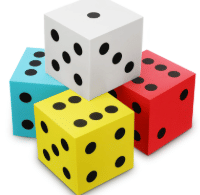
Types of Questions on Cubes and Dices
The questions based on cubes and dice can be categorized into the following types:
1. Dice-Based Questions
These questions test your ability to analyze different faces of a dice.
Types of Dice Questions:
Standard Dice vs. Non-Standard Dice:
A standard dice has opposite faces summing up to 7 (e.g., 1 opposite 6, 2 opposite 5, 3 opposite 4).
A non-standard dice does not follow this rule.
Finding Opposite Faces of a Dice:
If two different views of a dice are given, we can determine the opposite faces.
Finding a Missing Number on a Dice:
If multiple positions of a dice are shown, a missing number or face can be determined.
Rotation and Movement of Dice:
A question may ask what happens if a dice is rotated clockwise, anticlockwise, or flipped.
2. Cube-Based Questions
Cube-based reasoning questions involve cutting, coloring, arranging, or counting cubes in a given setup.
Types of Cube Questions:
Counting Number of Small Cubes After Cutting a Large Cube:
If a cube of side n × n × n is cut into smaller cubes of equal size, then the total number of small cubes is:
Total cubes = n³
Finding Number of Colored/Uncolored Cubes:
A cube is painted on some/all of its faces and then cut into smaller cubes.
Formulas:
One face painted: 6 × (n-2)²
Two adjacent faces painted: 12 × (n-2)
Three adjacent faces painted (Corner cubes): 8
No face painted (Inner cubes): (n-2)³
Predicting the Position of Cubes in an Arrangement:
Questions may involve identifying missing cubes or predicting how cubes fit together in an arrangement.
Folding and Unfolding of Cubes:
A net diagram of a cube is provided, and the question asks to identify the resulting cube.
Important Concepts and Tricks
1. Opposite Faces of Dice Rule:
For a standard dice, the sum of opposite faces is always 7.
2. Dice Rotation Rule:
When a dice rotates left or right, only two faces remain unchanged.
When a dice is flipped, the bottom face moves to the top.
3. Shortcut for Counting Cubes:
If a cube is divided into smaller cubes, always apply the formula n³ to find the total number of cubes.
If a cube is painted on all faces, only 8 corner cubes have three sides painted.
Solved Examples
Question 1: How many dots lie opposite to the face having three dots, when the given figure is folded to form a cube?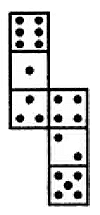
Solution:
On folding, face 6 will be opposite to the dice face with 3 dots
Question 2: A cube of side 4 cm is cut into 1 cm cubes. How many smaller cubes are formed?
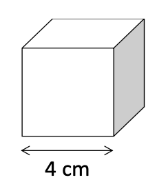
Solution:
- Total cubes = n³ = 4³ = 64
Question 3: A cube of side 5 cm is painted on all its faces and then cut into 1 cm cubes. How many cubes will have exactly one face painted?
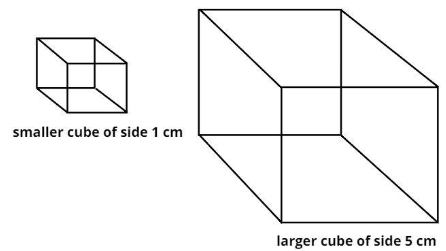
Solution:
- Number of cubes with one face painted = 6 × (n-2)² = 6 × (5-2)² = 6 × 9 = 54
Question 4: Three different positions X, Y and Z of a dice are shown in the figures given below. Which of the hidden numbers adjacent to 5 in position X is/are common to the hidden numbers adjacent to 5 in position Z?
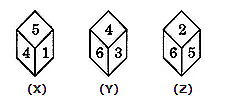
Solution:
- From the analysis of positions X and Y, we deduce that the numbers 1, 5, 6, and 3 are adjacent to 4. This leads us to conclude that 2 must be opposite to 4.
- Similarly, by examining positions Y and Z, we find that 4, 3, 2, and 5 are adjacent to 6, indicating that 1 is opposite to 6. Consequently, this arrangement means that 5 lies opposite to 3.
- Given that 3 is opposite to 5, it follows that the numbers 1, 4, 6, and 2 are adjacent to 5. In position X, the hidden numbers next to 5 are 6 and 2, while in position Z, the adjacent hidden numbers are 1 and 4. Notably, there is no common number shared between these two sets of adjacent numbers.
Question 5: In a dice a, b, c and d are written on the adjacent faces, in a clockwise order and e and f at the top and bottom. When c is at the top, what will be at the bottom?
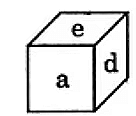
Solution:
The six faces are labeled as follows:
- Face I → a
- Face IV → b
- Face III → c
- Face II → d
- Face V → e
- Face VI → f
From this arrangement, 'a' is directly opposite to 'c'.
Therefore, if 'c' is on the top, then 'a' will be on the bottom.
Conclusion
Understanding the concepts of cubes and dice is crucial. The key to solving these questions is visualization, applying formulas, and practicing different variations. By following the strategies and shortcuts mentioned in this guide, you can improve your speed and accuracy in solving cube and dice problems.
Pro Tip:
Always visualize the dice movements carefully.
Memorize standard cube formulas for quick calculations.
Practice different types of questions regularly to master this topic!
|
164 videos|628 docs|1136 tests
|
FAQs on Cube and Dice - General Test Preparation for CUET UG - CUET Commerce
| 1. What are the common types of questions asked in cube and dice problems? |  |
| 2. How do I calculate the number of visible faces of a cube when it's partially hidden? |  |
| 3. What tricks can help me solve dice-related problems quickly? |  |
| 4. Can you provide an example of a cube and dice problem with a solution? |  |
| 5. How can I improve my skills in solving cube and dice problems for exams? |  |















